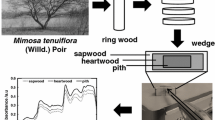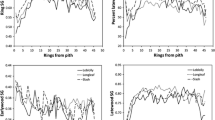Abstract
Wood density is one of the most important physical properties of the wood, used in improvement programs for wood quality of major timber species. Traditional core sampling of standing trees has been widely used to assess wood density profiles at high spatial resolution by X-ray microdensitometry methods, but alternative methods to predict wood properties quality are also needed. Near-infrared (NIR) spectroscopy, a non-destructive technique, is being increasingly used for wood property assessment and has already been demonstrated to be able to predict wood density. However, the estimation of wood density profiles by NIR has not yet been extensively studied, and improved models using spectra information (NIR) and X-ray data need to be developed. To this end, partial least square regression (PLS-R) models for predicting wood density were developed at a 1.4 mm spatial resolution on Pinus pinaster wood cores, with an improved spatial synchronization along the tangential and radial directions of the strip, between X-ray data and NIR spectra. The validation of the best model showed a high coefficient of determination (0.95), low error (0.026) and no outlier. Compression wood samples were not detected as outliers and were correctly predicted by the model. However, pith spectra were detected as outliers and its predicted values were overestimated by 33% due to unusual spectra suggesting a diverse chemical composition. The results suggest that NIR-PLS models obtained can be used for screening maritime pine wood density profiles along the radii at 1.4 mm spatial resolution.


Similar content being viewed by others
References
AEF (2016) https://www.mapa.gob.es/es/desarrollo-rural/estadisticas/aef_2016_estructuraforestal_tcm30-503579.pdfAccessed 11 October 2019
Alves A, Rodrigues J, Wimmer R, Schwanninger M (2008) Analytical pyrolysis as a direct method to determine the lignin content in wood. Part 2: evaluation of the common model and the influence of compression wood. J Anal Appl Pyrol 81:167–172. https://doi.org/10.1016/j.jaap.2007.11.001
Alves A, Gierlinger N, Schwanninger M, Rodrigues J (2009) Analytical pyrolysis as a direct method to determine the lignin content in wood Part 3. Evaluation of species-specific and tissue-specific differences in softwood lignin composition using principal component analysis. J Anal Appl Pyrol 85:30–37. https://doi.org/10.1016/j.jaap.2008.09.006
Alves A, Santos A, Rozenberg P, Paques LE, Charpentier JP, Schwanninger M, Rodrigues J (2012) A common near infrared-based partial least squares regression model for the prediction of wood density of Pinus pinaster and Larix x eurolepis. Wood Sci Technol 46:157–175. https://doi.org/10.1007/s00226-010-0383-x
Anonimous (1997) Launch of SilviScan-2: a breakthrough in wood fibre analysis. Appita J 50:447–448
Baettig R, Cornejo J, Guajardo J (2017) Evaluation of intra-ring wood density profiles using NIRS: comparison with the X-ray method. Ann Forest Sci. https://doi.org/10.1007/s13595-016-0597-7
Bouffier L, Charlot C, Raffin A, Rozenberg P, Kremer A (2008) Can wood density be efficiently selected at early stage in maritime pine (Pinus pinaster Ait.)? Ann Forest Sci 65:106. https://doi.org/10.1051/forest:2007078
da Silva Perez DD, Guillemain A, Alazard P, Plomion C, Rozenberg P, Rodrigues J, Alves A, Chantre G (2007) Improvement of Pinus pinaster Ait elite trees selection by combining near infrared spectroscopy and genetic tools. Holzforschung 61:611–622. https://doi.org/10.1515/hf.2007.118
Dias A, Gaspar MJ, Carvalho A, Pires J, Lima-Brito J, Silva ME, Lousada JL (2018) Within-and between-tree variation of wood density components in Pinus nigra at six sites in Portugal. Ann For Sci 75:58. https://doi.org/10.1007/s13595-018-0734-6
Evans R (1994) Rapid measurement of the transverse dimensions of tracheids in radial wood sections from Pinus radiata. Holzforschung 48:168–172. https://doi.org/10.1515/hfsg.1994.48.2.168
Evans R, Downes G, Menz D, Stringer S (1995) Rapid measurement of variation in tracheid transverse dimensions in a radiata pine tree. Appita J 48(2):134
Fernandes A, Lousada J, Morais J, Xavier J, Pereira J, Melo-Pinto P (2013a) Comparison between neural networks and partial least squares for intra-growth ring wood density measurement with hyperspectral imaging. Comput Electron Agr 94:71–81. https://doi.org/10.1016/j.compag.2013.03.010
Fernandes A, Lousada J, Morais J, Xavier J, Pereira J, Melo-Pinto P (2013b) Measurement of intra-ring wood density by means of imaging VIS/NIR spectroscopy (hyperspectral imaging). Holzforschung 67:59–65. https://doi.org/10.1515/hf-2011-0258
Fernandes C, Gaspar MJ, Pires J, Alves A, Simões R, Rodrigues JC, Silva ME, Carvalho A, Lima-Brito J, Lousada JL (2017a) Physical, chemical and mechanical properties of Pinus sylvestris wood at five sites in Portugal. iForest 10:669–679. https://doi.org/10.3832/ifor2254-010
Fernandes C, Gaspar MJ, Pires J, Silva ME, Carvalho A, Lima-Brito J, Lousada JL (2017b) Within and between-tree variation of wood density components in Pinus sylvestris at five sites in Portugal. Eur J Wood Prod. 75(4):511–526. https://doi.org/10.1007/s00107-016-1130-2
Gaspar M, Lousada JL, Silva M, Aguiar A, Almeida H (2008a) Age trends in genetic parameters of wood density components in 46 half-sibling families of Pinus pinaster Ait. Canad J Forest Res 38:1470–1477
Gaspar M, Lousada JL, Aguiar A, Almeida H (2008b) Genetic correlations between wood quality traits of Pinus pinaster Ait. Ann For Sci 65(7):703. https://doi.org/10.1051/forest:2008054
Gaspar MJ, Lousada JL, Rodrigues JC, Aguiar A, Almeida MH (2009) Does selecting for improved growth affect wood quality of Pinus pinaster in Portugal? Forest Ecol Manag 258:115–121. https://doi.org/10.1016/j.foreco.2009.03.046
Gaspar M, Alves A, Lousada JL, Morais J, Santos A, Fernandes C, Almeida M, Rodrigues J (2011) Genetic variation of chemical and mechanical traits of maritime pine (Pinus pinaster Aiton Correlations with wood density components. Ann For Sci 68(2):255–265. https://doi.org/10.1007/s13595-011-0034-x
Hevia A, Crabiffosse A, Álvarez-González JG, Ruiz-González AD, Majada J (2017) Novel approach to assessing residual biomass from pruning: a case study in Atlantic Pinus pinaster Ait. timber forests. Renew Energ 107:620–628. https://doi.org/10.1016/j.renene.2017.02.029
Hevia A, Campelo F, Chambel R, Vieira J, Alía R, Majada J, Sánchez-Salguero R (2020) What matters more for wood traits in Pinus halepensis Mill., provenance or climate? Annals For Sci 77:55. https://doi.org/10.1007/s13595-020-00956-y
ICNF (2015) http://www2.icnf.pt/portal/florestas/ifn/resource/doc/ifn/IFN6-Principais-resultados-Jun2019.pdf. Accessed 11 October 2019
Jacquin P, Longuetaud F, Leban JM, Mothe F (2017) X-ray microdensitometry of wood: a review of existing principles and devices. Dendrochronologia. https://doi.org/10.1016/j.dendro.2017.01.004
Jones PD, Schimleck LR, So CL, Clark A, Daniels RF (2007) High resolution scanning of radial strips cut from increment cores by near infrared spectroscopy. Iawa J 28:473–484. https://doi.org/10.1163/22941932-90001657
Leblon B, Adedipe O, Hans G et al (2013) A review of near-infrared spectroscopy for monitoring moisture content and density of solid wood. Forest Chron 89:595–606. https://doi.org/10.5558/tfc2013-111
Louzada JL (2003) Genetic correlations between wood density components in Pinus pinaster Ait. Ann For Sci 60(3):285–294. https://doi.org/10.1051/forest:2003020
Louzada JL, Fonseca FMA (2002) The heritability of wood density components in Pinus pinaster Ait. and the implications for tree breeding. Ann Forest Sci 59:867–873. https://doi.org/10.1051/forest:2002085
Ma T, Inagaki T, Tsuchikawa S (2017) Calibration of SilviScan data of Cryptomeria japonica wood concerning density and microfibril angles with NIR hyperspectral imaging with high spatial resolution. Holzforschung 71:341–347. https://doi.org/10.1515/hf-2016-0153
Macdonald E, Hubert J (2002) A review of the effects of silviculture on timber quality of Sitka spruce. Forestry 75(2):107–138. https://doi.org/10.1093/forestry/75.2.107
Mäkinen H, Saranpää P, Linder S (2002) Wood-density variation of Norway spruce in relation to nutrient optimization and fibre dimensions. Can J Forest Res 32:185–194. https://doi.org/10.1139/x01-186
Meder R, Marston D, Ebdon N, Evans R (2010) Spatially-resolved radial scanning of tree increment cores for near infrared prediction of microfibril angle and chemical composition. J Near Infrared Spec 18:499–505. https://doi.org/10.1255/jnirs.903
Pan YY, Li SC, Wang CL, Ma WJ, Xu GY, Shao L, Li KL, Zhao XY, Jiang TB (2018) Early evaluation of growth traits of Larix kaempferi clones. J Forestry Res 29:1031–1039. https://doi.org/10.1007/s11676-017-0492-6
Pâques LE, Foffová E, Heinze B, Lelu-Walter MA, Liesebach M, Philippe G (2013) Larches (Larix sp.) In: Pâques LE (Ed.), Forest tree breeding in Europe. Current state-of-the-art and perspectives. Springer, Dordrecht Heidelberg, New York, London https://doi.org/10.1007/978-94-007-6146-9
Polge H (1966) Etablissement des courbes de variation de la densité du bois par exploration densitométrique de radiographies d’échantillons prélevés à la tarière sur des arbres vivants. (Establishment of wood density variation curves by densitometric exploration of radiographs of core samples from living trees: applications in the technological and physiological fields. Application dans les domains technologiques et physiologiques). PhD thesis, Nancy University, France. p 206
Polge H (1978) Fifteen years of wood radiation densitometry. Wood Sci Technol 12:187–196. https://doi.org/10.1007/bf00372864
Pot D, Chantre G, Rozenberg P, Rodrigues J, Jones GL, Pereira H, Hannrup B, Cahalan C, Plomion C (2002) Genetic control of pulp and timber properties in maritime pine (Pinus pinaster Ait.). Ann Forest Sci 59:563–575. https://doi.org/10.1051/forest:2002042
Pot D, Rodrigues J, Rozenberg P, Chantre G, Tibbits J, Cahalan C, Pichavant F, Plomion C (2006) QTLs and candidate genes for wood properties in maritime pine (Pinus pinaster Ait.). Tree Genet Genomes 2:10–24. https://doi.org/10.1007/s11295-005-0026-9
Rodrigues JC, Fujimoto T, Schwanninger M, Tsuchikawa S (2013) Prediction of wood density using near infrared-based partial least squares regression models calibrated with X-ray microdensity. NIR News 24(2):4–8. https://doi.org/10.1255/nirn.1352
Rozenberg P, Cahalan C (1997) Spruce and wood quality: genetic aspects (a review). Silvae Genet 46:270–279
Rozenberg P, Franc A, Bastien C, Cahalan C (2001) Improving models of wood density by including genetic effects: a case study in Douglas-fir. Ann Forest Sci 58:385–394. https://doi.org/10.1051/forest:2001132
Saranpää P (2003) Wood density and growth. In: Barnett JR, Jeronimidis G (eds) Wood quality and its biological basis. Biological sciences series. Blackwell Publishing Ltd., Oxford, pp 87–117
Schwanninger M, Rodrigues J, Fackler K (2011) A review of band assignments in near infrared spectra of wood and wood components. J Near Infrared Spec 19:287–308. https://doi.org/10.1255/jnirs.955
Timell TE (1986) Compression wood in gymnosperms, vol 1–3. Springer, Berlin
Tsuchikawa S (2007) A review of recent near infrared research for wood and paper. Appl Spectrosc Rev 42:43–71. https://doi.org/10.1080/05704920601036707
Tsuchikawa S, Kobori H (2015) A review of recent application of near infrared spectroscopy to wood science and technology. J Wood Sci 61:213–220. https://doi.org/10.1007/s10086-015-1467-x
Tsuchikawa S, Schwanninger M (2013) A review of recent near-infrared research for wood and paper (part 2). Appl Spectrosc Rev 48:560–587 https://doi.org/10.1080/05704928.2011.621079
WinDENDRO (2009) WinDendro reference manual. Regent Instruments, Quebec
Wu HX, Powell MB, Yang JL, Ivković M, Mcrae TA (2007) Efficiency of early selection for rotation-aged wood quality traits in radiata pine. Ann Forest Sci 64(1):1–9. https://doi.org/10.1051/forest:2006082
Zobel BJ, van Buijtenen JP (1989) Wood variation: its causes and control Berlin. Springer, Germany
Acknowledgements
This work was supported by the Fundação para a Ciência e a Tecnologia, I.P, through Centro de Estudos Florestais [UID/AGR/00239/2019] and RTA2017-00063-C04-02 (Programa estatal de I + D+i Orientada a los Retos de la Sociedad, INIA) The first author was supported by the Fundação para a Ciência e a Tecnologia, I.P, through a contract-DL57/2016/CP1382/CT0005, and the second, AH, by PinCaR project (UHU-1266324, FEDER Funds, Andalusia Regional Government, Consejería de Economía, Conocimiento, Empresas y Universidad 2014-2020). This article is based upon work from project “Prediction of aleppo & maritime pine wood properties using NIR”, co-funded by the European Union Seventh Framework ProgrammeFP7 under grant agreement n° 284181 “Trees4Future”.
Author information
Authors and Affiliations
Corresponding author
Ethics declarations
Conflict of interest
The authors declare no conflict of interest.
Additional information
Publisher's Note
Springer Nature remains neutral with regard to jurisdictional claims in published maps and institutional affiliations.
Rights and permissions
About this article
Cite this article
Alves, A., Hevia, A., Simões, R. et al. Improving spatial synchronization between X-ray and near-infrared spectra information to predict wood density profiles. Wood Sci Technol 54, 1151–1164 (2020). https://doi.org/10.1007/s00226-020-01207-z
Received:
Published:
Issue Date:
DOI: https://doi.org/10.1007/s00226-020-01207-z




